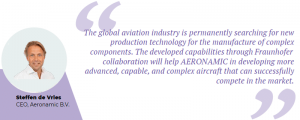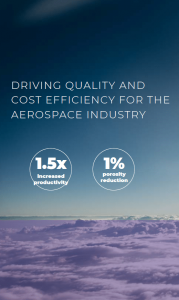3D2SKY: DRIVING QUALITY AND COST EFFICIENCY FOR THE AEROSPACE INDUSTRY
Driving Quality and Cost Efficiency for the Aerospace Industry
The aerospace industry has applied additive manufacturing (AM) to alleviate supply chain constraints from traditional manufacturing processes such as casting. AERONAMIC’s major customers are taking major steps towards developing processes and products around AM. AERONAMIC chose Fraunhofer Project Center at the University of Twente (FPC@UT) as a technology partner in a project aimed at the acquisition of knowledge and expertise using AM.

The aerospace industry has applied additive manufacturing (AM) to alleviate supply chain constraints from traditional manufacturing processes such as castings. An example is AERONAMIC, whose business is the design, production, testing and repair & overhaul of highly complex turbo machinery, motor driven systems and critical high-precision components for both commercial and defense industries. The customers of AERONAMIC are taking major steps towards developing processes and products around AM. To develop these competences, AERONAMIC chose the Fraunhofer Project Center at the University of Twente as a technology partner to gain direct access to the Fraunhofer network of knowledge in the development of processes in AM. The results of the collaboration have been encouraging with AERONAMIC recording 1.5X increased productivity, reduced material wastage and reduced porosity below 1%.
Additive manufacturing (AM) technology is on the verge of a breakthrough for many users who are considering its application in their supply chain strategy. It is defined as the process of producing parts through the deposition of material in a layer-by-layer fashion. If businesses are to use AM, they have two alternatives. The first option is to acquire AM service providers supply parts, which they can then handle in a similar way to how they have always dealt with castings. The second option is to integrate AM knowledge and application in-house. For AERONAMIC the latter is the right path to take since it brings increased added value and provides best value to customers. Through its knowledge partner, direct transfer of advanced manufacturing knowledge into industrial practices is obtained.

AERONAMIC performs a variety of machining tasks and processes on castings that come from outside suppliers. These castings are normally of a high standard but there are chances of casting pores occurring in regions that are only unveiled after numerous machining tasks. Also, before the COVID-19 pandemic, foundries had significant challenges to keep up with increasing demand. Therefore, they wanted a solution that would reduce the reliance on an outside supplier at a critical stage of their supply chain. Furthermore, they wanted to be in better control of the quality of the near-net shape of the part to be machined.
This became an ideal opportunity for them to explore the use of AM to replace the casting process.
At the same time, it was understood that the real benefit of additive manufacturing lies in (re)designing for AM. AERONAMIC closely worked with the Fraunhofer Project Center to develop significant in-house knowledge of AM that would allow them to prepare for future possibilities. FPC@UT was engaged to further develop the process for product optimization to gain cost efficiencies without compromising quality. A series of procedures and tests were carried out to define new parameters to obtain the best and most consistent quality. Aeronamic had already selected the machine by itself, AERONAMIC opted for an EOS M290 machine running Inconel 718 with possible expansion to more (multi-laser) machines and other materials. In this particular case, it is interesting to note that the functionality of the part designs was not changed in any way. Fraunhofer helped Aeronamic in evaluating, selecting and developing AM processes with their supporting technologies and integration into their value chain.
Currently, AERONAMIC is working towards optimizing throughput, whilst ensuring that part quality is not affected. They are very pleased to have an in-house system that provides greater control of their supply chain. At the same time, AERONAMIC can ensure high quality and reliability in their product and process. Additional benefits include in-depth knowledge of the high-end additive manufacturing of aerospace-grade products. This makes them ready for any additional improvements that may come from the re-design of products that can take advantage of AM, such as the use of topology optimization, light-weighting, and part consolidation.
AERONAMIC’s collaboration with FPC@UT on this particular project has demonstrated that through AM, optimized designs can be made in the future with fewer manufacturing constraints. The optimization of throughput that came along with effective capacity utilisation of the machine is of particular interest.
